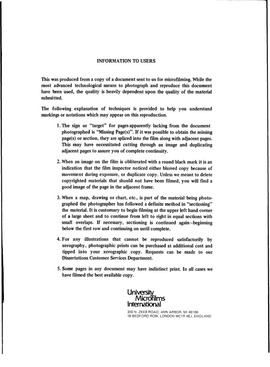| dc.contributor.author | Siler, Ina Cathy, | en_US |
| dc.date.accessioned | 2013-08-16T12:28:06Z | |
| dc.date.available | 2013-08-16T12:28:06Z | |
| dc.date.issued | 1980 | en_US |
| dc.identifier.uri | https://hdl.handle.net/11244/4755 | |
| dc.description.abstract | The purpose of this study was to investigate whether college instructors use verbal statements with students they perceive as acceptable classroom communicators that are different from the verbal statements they use with students they perceive as unacceptable classroom communicators. Graduate teaching assistants in the Department of Communication at the University of Oklahoma were observed as they interacted with students in their introductory speech communication courses. Teachers were asked to complete the Student Classroom Communication Behavior Scale (SCCBS) for every student in their classes. The SCCBS, which had eight bipolar adjective scales employing a nine point semantic differential scaling procedure, was designed to determine whether teachers perceived their students as acceptable or unacceptable classroom communicators. The instrument measured: (1) student initiated interaction with teacher; (2) student response style with teacher; and (3) student interaction with classmates. Ten teachers were selected to be observed based on whether they had students rated high and low on the SCCBS in their classes. Observations of teacher-student interactions were made by videotaping classes for a six week period. Teachers' statements then were coded according to the ten categories of a modified Perkins Teacher Behavior Observation System. Only teachers' statements to students rated high or rated low on the SCCBS were coded. | en_US |
| dc.description.abstract | Seven hypotheses were tested. In general, the findings indicated: teachers did not use verbal statements with students rated high that were significantly different from the verbal statements that they used with students rated low; teachers did not use significantly more statements in their messages to students rated high than to students rated low; and there were significantly more interactions between teachers and students rated high than between teachers and students rated low. | en_US |
| dc.description.abstract | In addition to the seven hypotheses, an exploratory research question was posited to examine areas related to the way teachers interact with students and the way teachers organize the verbal statements in their messages to students. The preliminary findings showed: that students rated high tend to initiate interactions with teachers; teachers tend to initiate interactions with students rated low; teachers tend to use more praising statements in messages and use partial rejection with students rated high; and teachers tend to use fewer praising statements in messages and total rejection with students rated low. Overall, organizational patterns in teachers' messages to students rated high were easier to identify than the organizational patterns in teachers' messages to students rated low. | en_US |
| dc.format.extent | vii, 96 leaves ; | en_US |
| dc.subject | Speech Communication. | en_US |
| dc.title | The use of verbal statements by college-level communication instructors during classroom interactions with students rated acceptable or unacceptable classroom communicators. | en_US |
| dc.title.alternative | Use of verbal statements by college-level communication instructors during classroom interactions ... | en_US |
| dc.type | Thesis | en_US |
| dc.thesis.degree | Ph.D. | en_US |
| dc.thesis.degreeDiscipline | Department of Communication | en_US |
| dc.note | Source: Dissertation Abstracts International, Volume: 41-05, Section: A, page: 1838. | en_US |
| ou.identifier | (UMI)AAI8024423 | en_US |
| ou.group | College of Arts and Sciences::Department of Communication | |
